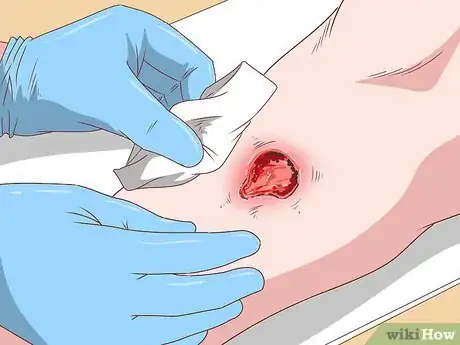This article was co-authored by Chris M. Matsko, MD. Dr. Chris M. Matsko is a retired physician based in Pittsburgh, Pennsylvania. With over 25 years of medical research experience, Dr. Matsko was awarded the Pittsburgh Cornell University Leadership Award for Excellence. He holds a BS in Nutritional Science from Cornell University and an MD from the Temple University School of Medicine in 2007. Dr. Matsko earned a Research Writing Certification from the American Medical Writers Association (AMWA) in 2016 and a Medical Writing & Editing Certification from the University of Chicago in 2017.
There are 8 references cited in this article, which can be found at the bottom of the page.
This article has been viewed 66,259 times.
Pseudomonas are a type of bacteria that generally only cause serious infections in people with weakened immune systems. This means that the people who are most vulnerable are patients who are very ill and in the hospital. These infections are usually treated with antibiotics. Finding an effective antibiotic may be difficult because these bacteria are becoming resistant to many commonly prescribed drugs. However, if a sample of the bacteria is sent to the lab and tested, it should be possible to treat.[1]
Steps
Recognizing and Treating Mild Pseudomonas
-
1Recognize a mild case of Pseudomonas. Pseudomonas usually produce mild symptoms in healthy people with strong immune systems. These infections may be water-borne. There have been reports of:[2]
- Eye infections in people who use extended-wear contact lenses. To avoid this, change your contact lens solution instead of topping it up. Do not wear your contacts for longer than recommended by your doctor or the manufacturer's instructions.
- Ear infections in children after swimming in contaminated water. This can occur if the pool does not have enough chlorine to adequately disinfect it.
- Skin rashes after using a contaminated hot tub. This rash generally manifests as itchy red bumps or blistered filled with fluid around the hair follicles. It may be worse in areas where your skin was covered by a bathing suit.[3]
-
2Know symptoms of different pseudomonas infections. Signs and symptoms of pseudomonas depend on where the infection occurs.[4]
- Blood infections are characterized by fever, chills, fatigue, muscle and joint pains, and are extremely serious.
- Lung infections (pneumonia) include symptoms like chills, fever, a productive cough, difficulty breathing.
- Skin infections may cause an itchy rash, bleeding ulcers, and/or headache.
- Ear infections may present with swelling, ear pain, itching inside the ear, discharge from the ear, and difficulty hearing.
- Eye infections caused by pseudomonas may include the following symptoms: inflammation, pus, swelling, redness, pain in the eye, and impaired vision.
Advertisement -
3Go to the doctor for a diagnosis. The doctor will likely want to look at the rash and may take a sample of the bacteria to send to the lab to confirm the diagnosis. This may be done in two ways:[5]
- Swabbing the infection on your skin
- Taking a biopsy. Doing a biopsy is rare.
-
4Discuss treatment options with your doctor. If you are otherwise healthy, treatment may not be necessary. Your immune system may clear the infection itself. However, your doctor may suggest:[6]
- Anti-itch medications if you have an itchy rash
- Antibiotics if you have a serious infection. The doctor may be more likely to prescribe antibiotics if you have an infection in your eye.
Recognizing and Treating Severe Cases
-
1Talk to your doctor if you may be at risk. Pseudomonas are most dangerous for people who are in hospitals and have weakened immune systems. Newborns have a higher risk. As an adult, you may have a higher risk if:[7] [8]
- You are being treated for cancer
- You have HIV/AIDS
- You have cystic fibrosis
- You are on a breathing machine
- You are recovering from surgery
- You have a catheter
- You are recovering from severe burns
- You have diabetes mellitus
-
2Alert your doctor if you think you are infected. Tell your doctor as soon as possible because you will need prompt attention. Pseudomonas can manifest as many different types of infections, depending on where they are located in your body. You may have:[9]
- Pneumonia. This may be associated with an infected breathing machine.
- An eye infection
- An ear infection
- A urinary tract infection that is introduced by a catheter
- An infected surgical wound
- An infected ulcer. This may occur to patients that are on prolonged bed rest and develop sores.
- A blood infection that enters through an intravenous line
-
3Discuss medications with your doctor. Your doctor may take a swab sample and send it to the lab to confirm exactly what strain is infecting you. The lab may also be able to help determine what drugs are likely to be effective against the infection. Pseudomonas are often resistant to many commonly prescribed drugs. For many of the drugs that are effective, it is important that your doctor know your complete medical history, particularly if you think you could be pregnant or if you have renal (kidney) impairment. The doctor may prescribe:[10] [11] [12]
- Ceftazidime. This is usually effective against a common form, Pseudomonas aeruginosa. It may be administered as an intramuscular injection or through an IV. It may not be appropriate for patients who are allergic to penicillin.
- Piperacillin/Tazobactam (Tazocin). This is also effective against Pseudomonas aeruginosa. It may interact with other medications, so give your doctor a complete list of what you take. This includes over-the-counter medications, herbal remedies, and supplements.
- Imipenem. This is a broad-spectrum antibiotic which is often administered with cilastatin. The cilastatin increases the half-life of the imipenem and can also help it better penetrate tissue.
- Aminoglycosides (Gentamicin, Tobramycin, Amikacin). The dosages of these drugs may need to be adjusted according to your body weight and the health of your kidneys. Your doctor may monitor your blood and hydration levels during these treatments, as side effects can include kidney damage (such as nephrotoxicity) or ear and hearing damage.
- Ciprofloxacin. This can be taken orally or intravenously. Tell your doctor if you have epilepsy, renal impairment, or think you may be pregnant.
- Colistin. This can be taken orally, intravenously, or in a nebulized form.
-
4Make dietary and activity changes as recommended by your doctor. Some patients, such as those with cystic fibrosis, may need to change their diet and activity levels to ensure proper nutrition and promote healing.[13] [14]
- If you are on a ventilator to help you breathe, your doctor may recommend a diet that is higher in fats and lower in carbohydrates. Carbohydrates can increase the amount of carbon dioxide your body produces, making breathing more difficult when you are on a ventilator.
- If you have a systemic infection, you may need to limit your activity levels. This may not be the case for a localized infection.
Expert Q&A
-
QuestionI have a suprapubic catheter. I am taking gentamicin for pseudomonas. How long should I take the drug?
 Chris M. Matsko, MDDr. Chris M. Matsko is a retired physician based in Pittsburgh, Pennsylvania. With over 25 years of medical research experience, Dr. Matsko was awarded the Pittsburgh Cornell University Leadership Award for Excellence. He holds a BS in Nutritional Science from Cornell University and an MD from the Temple University School of Medicine in 2007. Dr. Matsko earned a Research Writing Certification from the American Medical Writers Association (AMWA) in 2016 and a Medical Writing & Editing Certification from the University of Chicago in 2017.
Chris M. Matsko, MDDr. Chris M. Matsko is a retired physician based in Pittsburgh, Pennsylvania. With over 25 years of medical research experience, Dr. Matsko was awarded the Pittsburgh Cornell University Leadership Award for Excellence. He holds a BS in Nutritional Science from Cornell University and an MD from the Temple University School of Medicine in 2007. Dr. Matsko earned a Research Writing Certification from the American Medical Writers Association (AMWA) in 2016 and a Medical Writing & Editing Certification from the University of Chicago in 2017.
Family Medicine Physician If you have a suprapubic catheter, you need to take the medication as long as prescribed by your urologist.
If you have a suprapubic catheter, you need to take the medication as long as prescribed by your urologist. -
QuestionI have a pseudomonas infection from the removal of a cyst in my leg and I cannot take Cipro. What else can I do?
 Chris M. Matsko, MDDr. Chris M. Matsko is a retired physician based in Pittsburgh, Pennsylvania. With over 25 years of medical research experience, Dr. Matsko was awarded the Pittsburgh Cornell University Leadership Award for Excellence. He holds a BS in Nutritional Science from Cornell University and an MD from the Temple University School of Medicine in 2007. Dr. Matsko earned a Research Writing Certification from the American Medical Writers Association (AMWA) in 2016 and a Medical Writing & Editing Certification from the University of Chicago in 2017.
Chris M. Matsko, MDDr. Chris M. Matsko is a retired physician based in Pittsburgh, Pennsylvania. With over 25 years of medical research experience, Dr. Matsko was awarded the Pittsburgh Cornell University Leadership Award for Excellence. He holds a BS in Nutritional Science from Cornell University and an MD from the Temple University School of Medicine in 2007. Dr. Matsko earned a Research Writing Certification from the American Medical Writers Association (AMWA) in 2016 and a Medical Writing & Editing Certification from the University of Chicago in 2017.
Family Medicine Physician There is a list of mediations above. A common medication for pseudomonas given in the hospital is Piperacillin/tazobactam.
There is a list of mediations above. A common medication for pseudomonas given in the hospital is Piperacillin/tazobactam.
Warnings
- Tell your doctor if you think you might be pregnant before starting any medications.⧼thumbs_response⧽
References
- ↑ http://www.cdc.gov/hai/organisms/pseudomonas.html
- ↑ http://www.cdc.gov/hai/organisms/pseudomonas.html
- ↑ http://www.cdc.gov/healthywater/swimming/rwi/illnesses/hot-tub-rash.html
- ↑ https://www.merckmanuals.com/home/infections/bacterial-infections-gram-negative-bacteria/pseudomonas-infections
- ↑ http://www.mayoclinic.org/diseases-conditions/folliculitis/basics/tests-diagnosis/con-20025909
- ↑ https://www.nlm.nih.gov/medlineplus/ency/article/001460.htm
- ↑ http://www.cdc.gov/hai/organisms/pseudomonas.html
- ↑ https://www.gov.uk/government/collections/pseudomonas-aeruginosa-guidance-data-and-analysis
- ↑ https://www.merckmanuals.com/home/infections/bacterial-infections-gram-negative-bacteria/pseudomonas-infections
- ↑ http://www.cdc.gov/hai/organisms/pseudomonas.html
- ↑ https://www.gov.uk/government/collections/pseudomonas-aeruginosa-guidance-data-and-analysis
- ↑ https://www.merckmanuals.com/home/infections/bacterial-infections-gram-negative-bacteria/pseudomonas-infections
- ↑ http://emedicine.medscape.com/article/970904-treatment#d8
- ↑ http://emedicine.medscape.com/article/970904-treatment#d9



















-Step-11.webp)


















































Medical Disclaimer
The content of this article is not intended to be a substitute for professional medical advice, examination, diagnosis, or treatment. You should always contact your doctor or other qualified healthcare professional before starting, changing, or stopping any kind of health treatment.
Read More...